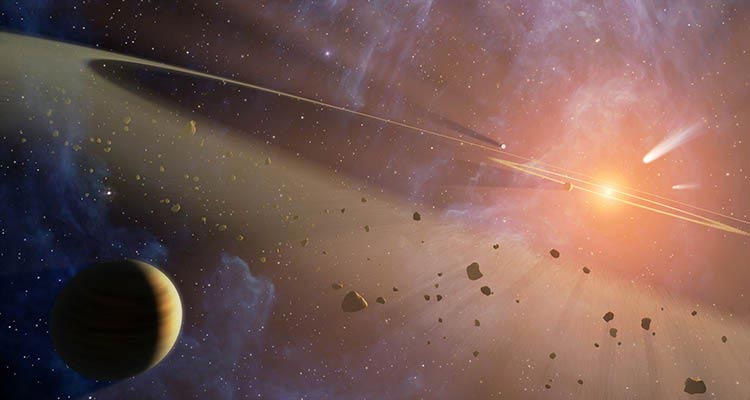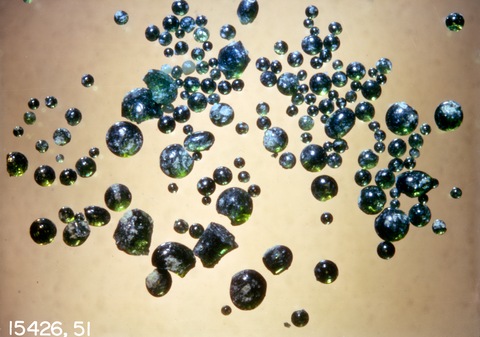Water has been identified in the most uncanny of places – as vapors in the nebulae that roam our Milky Way Galaxy, as ices in the protoplanetary disks that surround many protostars, and as liquids below the icy crusts of the Jovian moons Europa, Ganymede, and Callisto. In 2005, the Cassini spacecraft imaged geysers of liquid water erupting from the surface of Saturn’s moon Enceladus. The liquid form of water is especially important to biotic processes, as it provides an essential solvent for making the sundry hookups and energy transfers that are necessary to life.
Despite compelling evidence for water throughout our Milky Way Galaxy and within our local Solar System, the specific origin of water on Earth remains controversial. We know that the Earth formed some 4.6 billion years ago, as the primordial Solar System gravitationally congealed from the pre-planetary disk of debris that surrounded the proto-Sun. Once the Sun “turned on” its thermonuclear fires, things began to change in a big way.

The primitive Solar System was a busy chaotic place. Did Earth’s cargo of precious water come home-grown 4.6 billion years ago or was it delivered via comets during the Late Heavy Bombardment that ended 3.9 billion years ago? (Caltech-JPL/NASA)
Some scientists contend that the inner Solar System was too hot for any water to remain in the rocky bits that ultimately came together to form the Earth. They look to wayward comets and asteroids that formed farther from the scalding Sun as the key provisioners of Earth’s oceans. However, others find important discrepancies in the relative amounts of regular water and “heavy” (deuterated) water in their comparisons of the Earth, comets, and meteorites. The few comets that have been chemically probed appear to have far more deuterated water than Earth’s oceans – indicating (to these scientists at least) that comets could not have delivered the bulk of Earth’s water.
Meteorites are interplanetary rocks of various kinds that have fallen to Earth. They are thought to represent pieces of much larger asteroids that formed between the orbits of Mars and Jupiter. Some meteorites are found to be rich in water. Others are bone dry. Again, chemical and isotopic analyses seem to rule out asteroidal meteorites delivering most of Earth’s water, as they find that the early Earth was likely the beneficiary of mostly dry meteorites. The only way to wiggle around this situation is to have a single unusually wet and very large (Moon-size) body to hit Earth shortly after its birth. Something like the Jovian moon Europa could have done the trick.
Perhaps surprisingly, several scientists have gone back to square one – working out scenarios which retain the water in the inner Solar System despite the intense solar heating and intense bombardment by other rocky bodies. Here, the water was in the form of a warm vapor that stuck to tiny grains of rock which then aggregated to build up pebbles – and ultimately – a wet Earth. Once the Earth’s crust began to solidify, it would have belched out huge quantities of water during a period of rampant volcanic eruptions. As the saturated atmosphere cooled, it began to rain – and rain – and rain, filling the Earth’s basins with the water that we inherit to this day.
Recent support for this revived scenario of home-grown water has come from analyses of ancient zircons on Earth and, perhaps surprisingly, in lunar soil and rocks that were gathered by astronauts during the Apollo 15 and 17 missions to the Moon. The zircons found in Australia represent the oldest unaltered mineral crystallizations to be found on Earth. Radioactive dating of the uranium that forms part of the zircon crystals indicate ages of 4.4 billion years for the oldest zircons – corresponding to the time when the cooling Earth had just solidified from a molten state. The balance of oxygen isotopes within these minerals suggests a watery origin. Some scientists have used the zircon data to imagine a primordial Earth that was neither scalding nor blanketed by an arid stifling atmosphere of carbon dioxide. Instead, they suggest a rather clement world, whose tectonic activity (also indicated by the zircon properties) would have sequestered the carbon dioxide into carbonate rocks – leaving behind a moist temperate atmosphere and perhaps oceans that would have been hospitable to life.
On the Moon, the Apollo astronauts collected hundreds of pounds of lunar soil (regolith) and rocks. Subsequent analyses of the fine-grained regolith have revealed microscopic glass spherules that have incorporated small but significant amounts of water. These spherules are thought to have been created during a primordial period of intense lunar volcanism. The so-called “fire fountaining” produced mists of molten lava which then cooled into solid spheroidal droplets. Falling back down to the Moon’s surface, the tiny glass beads were collected intact by the Apollo astronauts approximately 3.7 billion years after their formation. Similar amounts of water (of order 1 part per 10,000) have been found inside lunar rocks that contain magnesium-rich olivine. These rocks are also thought to have originated deep inside the Moon in the form of magma which then rose toward the surface and crystallized.

Tiny green glass beads have been found in samples of lunar regolith that were collected during the Apollo 15 and 17 missions to the Moon. These spherules contain water as part of their mineral composition. The water appears to be identical in its isotopic properties to the water found on Earth, thus suggesting identical origins. (NASA)
Analyses of the lunar glass beads and magnesium-rich rocks have yielded ratios of deuterated vs. regular water that resemble those found on Earth and in carbonaceous chondrites (a type of meteorite that contains primitive chondrules – the first major crystallizations in the inner Solar System). These sorts of isotopic measurements are tricky, as the so-called D/H ratio can change as the sample undergoes weathering from cosmic rays, solar wind implantation, and degassing of the magma. Only after compensating for such effects did the investigators find the strong resemblance among the waters of the Earth, Moon, and carbonaceous chondrites – and a significant disparity with respect to the D/H ratios that have been measured in a handful of comets.
If these results hold up, Earth’s water was likely archived in place, when the inner planets and carbonaceous asteroids condensed from the proto-planetary disk some 4.6 billion years ago. That the Earth and Moon share similar waters indicate that the archiving took place before Earth experienced the big impact that led to the formation of the Moon 4.5 billion years ago. The early caching of water within the Earth, Moon, and carbonaceous chondrites would also suggest that water is ubiquitous throughout the inner Solar System. Moreover, water is likely to be present in the inner rocky parts of other planetary systems. And where there is water co-mingling with rocky surfaces, there is a much greater chance for life to emerge.
Further research on Earth’s watery past will likely benefit from future robotic probes and landers, whereby the isotopic composition of water across the Solar System can be assayed. That will help to pin down the status of oceanic water on Earth relative to the larger context of planetary, asteroidal, and cometary sources. Meanwhile, sub-millimeter spectroscopic observations of icy objects in the Kuiper Belt may help to determine the isotopic composition of these pristine Solar System objects beyond the orbit of Neptune. Closer to home, deep-sea probes will help to determine the isotopic composition of water emerging from the Earth’s upper mantle. So, the next time you drink a glass of water, think about those trillion-trillions of H2O molecules and their long strange journey to your lips. You may be tasting the first rains that ever fell on Earth.

William H. Waller earned his Ph.D. in astronomy at the University of Massachusetts. He has since carried out diverse programs in scientific research and education at the University of Washington, NASA’s Goddard Space Flight Center, Tufts University, and the Museum of Science – Boston. He is author of The Milky Way — An Insider’s Guide (see http://press.princeton.edu/titles/9938.html) and co-editor of The Galactic Inquirer – an e-journal and forum on the topics of galactic and extragalactic astronomy, cosmochemistry, astrobiology, and the prospects for interstellar communication (see
https://galacticinquirer.net). Bill currently teaches physical sciences at his hometown high school in Rockport, MA, and serves as a Zooniverse Teacher Ambassador (seehttp://www.zooniverse.org). He can be reached at williamhwaller@gmail.com.
